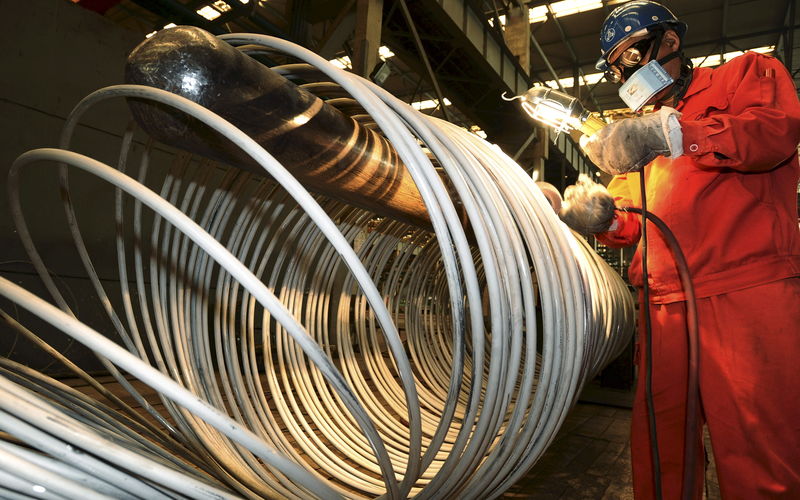(Repeats column published earlier with no changes to text. The opinions expressed here are those of the author, a columnist for Reuters.)
By Clyde Russell
PERTH, March 9 (Reuters) - If the price of the product your company produced had just experienced a 20 percent price surge in one day, its biggest jump ever, it would be reasonable for you to be overjoyed. But maybe not if you are an iron ore miner.
This month's leap in Asian spot iron ore prices coincided with the annual Global Iron Ore and Steel Forecast conference in Perth, capital of Western Australia state and home to the iron ore operations of three of the world's four biggest producers.
Spot iron ore .IO62-CNI=SI soared to $62.60 a tonne on March 7 from a prior close of $52.40, a record in percentage terms and the biggest dollar move in four years.
The problem for the insiders at the Perth conference is that as much as they would like to believe the move is sustainable, nobody really does.
The question that came up repeatedly was whether there was any fundamental justification for the gain, or whether it's just the market responding to a sentiment-driven rally by retail Chinese investors trading on the Dalian Commodity Exchange.
While it's certainly possible to construct a case that the outlook for Chinese steel demand has improved slightly in recent months, it's hard to argue that there has been enough of a change in the underlying market fundamentals that would support a prolonged recovery in iron ore prices.
The weekend meeting of China's ruling Communist party certainly provided sparks of good news, with a commitment to increase economic stimulation, as well as to rationalize the massive overcapacity among loss-making steel mills. a sentiment-driven price gain comes before any actual increase in physical demand, so in order for this rally to prove sustainable, it will have to be followed by signs of rising Chinese steel consumption, and thus higher iron ore imports.
There is also a growing realisation that the iron ore market is fundamentally changing via the Dalian futures contract DCIOcv1 .
While open interest has been rising, the contract is still largely a day-traded vehicle for small investors, and thus can be influenced by sentiment driven by reports in the Chinese-language media.
The rally on March 7 came after a weekend of events and announcements that would have been presented in a very positive light by many Chinese news outlets, helping to create momentum.
This increasing financialisation of iron ore will no doubt lead to higher volatility and periods when the futures markets appear to disconnect from fundamentals, similar to what can happen with crude oil.
LIFE AFTER COST-CUTTING?
Judging from the presentations at this week's conference in Perth, the increased dynamics in iron ore pricing and trading have yet to make much of a mark in the thinking of iron ore producers.
Both Rio Tinto (LON:RIO) RIO.AX and BHP Billiton (LON:BLT) BHP.AX used their presentations to talk about their success in driving down costs and their view that there is still more to come on that front.
There is no doubt that the achievement in cutting the cost of getting a tonne of iron ore to an export port down to around $15 is worthy of praise.
But there is also a feeling that the iron ore majors need to do more than just talk about costs, that they need to focus a bit more on strategy.
BHP Billiton's new head of iron ore assets, Edgar Basto, did take a moment to reiterate the company's view that China's steel output will peak around 935 million to 985 million tonnes a year in the mid-2020s.
Rio Tinto's manager for its Pilbara mines in Western Australia, Michael Gollschewski, however, didn't mention the company's forecast for Chinese steel output to rise to 1 billion tonnes a year by 2030.
He did say Rio Tinto believed iron ore capacity additions in 2016 would be matched by closures of higher-cost output, leaving the market in balance.
That's certainly possible, but it's also possible that any rally in iron ore prices, if sustained, will allow weaker players to stay in the market, especially in China, which is expected to provide the bulk of output curtailments.
For this reason alone, an iron ore rally looks unsustainable, even if there is an actual pick up in steel demand in China.
What still seems fairly evident is that the iron ore market will remain oversupplied, especially with the ramp up of output from Roy Hill, the newly commissioned 56 million-tonne-a-year mine in Western Australia's Pilbara region.
In some ways, the conference in Perth resembled an episode of the X-Files television show.
There are those in the industry who want to believe that the China steel story is far from over, even though they struggle to find evidence for this, just as the X-Files' FBI Agent Fox Mulder battles to prove his belief that aliens are on earth and influencing political events.
Then there are the others in the industry who believe the China Iron & Steel Association when it says 2014 was peak steel for China and domestic demand will drop from 646 million tonnes last year to something closer to 552 million tonnes by 2025.
The peak steel crowd are more like Mulder's long-suffering partner, Agent Dana Scully, who insists on verifiable evidence before believing Mulder's theories.
Right now the evidence is on the Scully side, with steel output and demand slowing, and little sign that China's economy will return to double digit growth, which would be the only way the 1 billion-tonne-a-year steel forecast could become reality.
(Edited by Tom Hogue)
